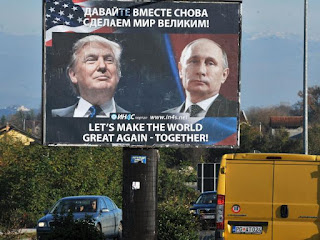While the US is Busy Putin Moves His Ballistic Missiles Around
 |
| A billboard by a pro — Serbian movement shows US President-elect Donald Trump and Russian President Vladimir Putin together in the town of Danilovgrad. Picture: AFP PHOTO / Savo PRELEVICSource:AFP |
RUSSIA’S decision to deploy short-range ballistic missiles to a crucial site in Europe is designed to create a “bargaining chip” with the incoming Trump administration, and project an image of awesome power in the region.
That’s according to the Royal United Services Institute’s Russia expert Dr Igor Sutyagin, who said Russian President Putin is “very skilful” at using psychology to provoke fear among rivals.
“That is the force equaliser that the Kremlin has now,” he said, following the US election which has raised questions about Mr Trump’s commitment to established alliances.
“Hybrid warfare is the Russian offset strategy. They are fundamentally weak against the united West — that is why they try to divide the West using fear and intimidation.
“What the Kremlin is doing now is displaying that they have stronger will than the will of the West. All these tricks with intimidation, deployments, is the way to exercise this will. It’s to prove that Russian will is stronger, there is no point to resist.”
The comments come after Russia announced it would move nuclear-capable missiles to Kaliningrad — a tiny Russian exclave between Poland and Lithuania which is the country’s main sea port in the Baltic. The move was described by US officials as “destabilising”.
Dr Sutyagin said the deployment in itself does not “change too much” from a military standpoint as it’s essentially replacing obsolete missiles that have been there since the 1970s and had been agreed upon more than 25 years ago. However the timing can be read as a message to officials while the political order is in flux.
“That is the message — that we are mighty and terrible and you need to take us seriously,” he said. “To intimidate, sell fear, create some bargaining chip with the new US administration.”
On Monday, Putin announced he would move the missiles after becoming “concerned” about NATO decision making which has seen a build-up of forces from European nations.
“We have, therefore, to take countermeasures, which means to target with our missile systems the facilities that in our opinion start posing a threat to us,” he said. Russia has also placed cruise missiles in the same area in October — ostensibly to deter the NATO force.
NATO called the Russian deployment “aggressive military posturing” and said it “does not help to lower tensions or restore predictability to our relations.”
The seven-decade old military alliance has emphasised its defensive nature, but called for transparency to “to avoid incidents and the risk of misunderstandings”.
US President-elect Donald Trump’s attitude to NATO will be remains to be seen. During the campaign he referred to the alliance — to which the US contributes the lion’s share — as “obsolete and extremely expensive”. He has also signaled a willingness to work with Russian President Vladimir Putin and said the US would “no longer be the stupid country” by footing the bill of other countries security.
news.com.au
news.com.au

Comments